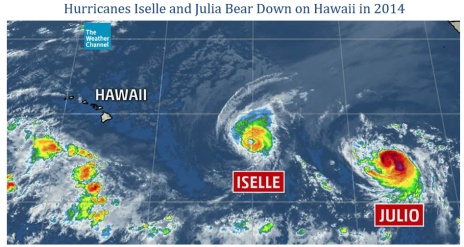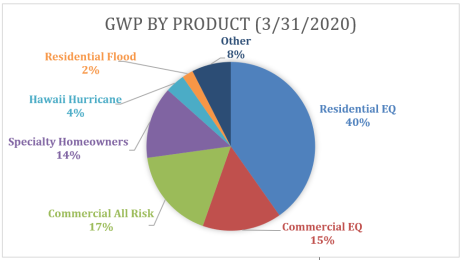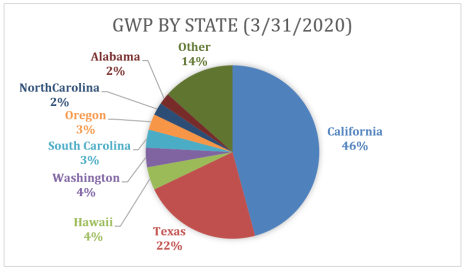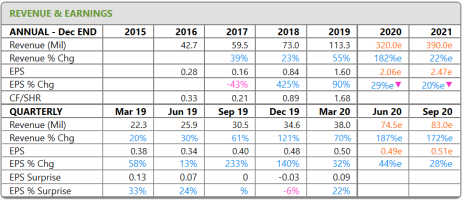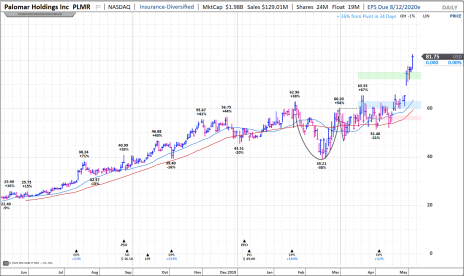Today we’re breaking into a familiar market by going back to the insurance industry.
But today’s addition is very different from our other rapid growth insurance companies in a major way (as you’ll soon see!).
The stock is acting strong and the fundamentals remain great, despite COVID-19.
All the details are inside this month’s Issue. Enjoy!
Cabot Small Cap Confidential 253
[premium_html_toc post_id="206890"]
The Big Idea
We’ve enjoyed tremendous success investing early in off-the-beaten path insurance brokerage companies.
This success is due, in large part, to selecting technology-enabled companies with business plans developed around efficiently capturing, and keeping, clients.
These companies include Goosehead Insurance (GSHD) and Everquote (EVER). Both are rapid-growth, high-valuation stocks that blow away most competitors in terms of top-line growth, operating efficiency and profitability.
Today we’re going deeper into the insurance industry, but down a very different path.
This company isn’t an insurance broker, but an underwriter. This is a compeletely different beast. Whereas the brokers don’t assume any real risk if policy holders experience losses, an underwriter does.
What makes this story even more of a departure from our previous adventures in insurance is that this company doesn’t sell personal lines insurance policies, like home, auto and health.
It mostly sells insurance for catastrophic events! This covers events like earthquakes, hurricanes, floods and fires
No surprise, this means many policies are written in coastal areas—places like California, Texas, Hawaii and North Carolina.
The thing is, while this all sounds very risky, managing risk is the core competency of this company. It doesn’t have to write hurricane insurance for every house in Hawaii, earthquake insurance for every commercial building in California and flood insurance for every coastal apartment building in Florida.
In fact, the company doesn’t write any policies in Florida, because the economics aren’t favorable.
Because of its underlying technolgy, which includes detailed geographic data, the company can pinpoint areas where the risk is acceptable, and avoid areas where it’s not. This approach is vastly different from the one-size-fits-all approach of many larger insurers.
Plus, risk can be reduced greatly through reinsurance policies, which allow the company to pass on, or cede, risk to another insurance company.
Is this an attractive industry? Depends on your perspective.
Warren Buffett didn’t grow Berkshire Hathaway into a massive company just by facilitating a connection between customers and insurance underwriters, for which he collected a commission. While that’s a great business too, Buffett made his billions underwriting the policies, collecting the premiums as float, and investing them, then doing so over, and over, and over again.
Over time he “won” far more than he lost in terms of managing risk. He was able to build and/or buy a lot of things with that float, including many of the high-profile companies that Berkshire still owns, such as GEICO.
We don’t exactly know where the company we’re investing in today will go. It was only founded six years ago.
But we do know that right now, it is growing a profitable specialty lines insurance underwriting business rapidly, and adding new products as it expands into attractive markets in the U.S.
It’s a compelling story. And while the stock has been a strong performer of late it still has a market cap under $2 billion.
The Company
Investors don’t typically equate earthquakes, hurricanes and floods with insurance carriers that deliver rapid revenue growth and consistent profitability.
But that’s exactly what’s we find with Palomar Holdings (PLMR), a provider of specialty insurance products for individuals and businesses.
Palomar, which has a market cap of $1.9 billion, was started in 2014 when it began selling earthquake insurance in 12 markets. It generated relatively modest gross written premiums (GWP) of $17 million its first year, but the company stood out from the competition because it went after geographic markets where there was little interest from other carriers, who took a generalist approach and used one-size-fits-all pricing strategies across large areas.
That opened the door to customers who needed something specific to their area. Palomar was able to move in and charge competitive rates, while balancing risk. It achieved this by developing a proprietary data analytics and technology platform that allowed for flexible products and granular pricing. A reinsurance program was soon added to provide protection from large loss, low frequency events.
The company then began to add more products and geographies, starting with Specialty Homeowners in Texas and Hawaii Hurricane in 2015, a year when GWP grew by 224% to $55 million.
Commercial All Risk and Real Estate Investor came in 2016, while Residential Flood and Inland Marine were added in 2017 and 2019, respectively.
In 2019 GWP hit $252 million, representing 63% growth over 2018.
That pace of written premium growth translated into revenue of $113 million in 2019, an increase of 55%. Adjusted EPS of $1.60 rose by 90%. That’s insane growth for this type of business.
As of the end of Q1 2020, combined residential and commercial earthquake insurance (55% of revenue) still accounts for the majority of business, while commercial all risk (17%) and specialty homeowners (14%) are the other leading products.
Geographically, Palomar’s expansion means it is now licensed in 27 states. Growth has been carrying the company eastward. Still, revenue remains very much concentrated in California and Texas.
Not only is new business good, but customers keep coming back. This is a good sign. Through Q1 2020 monthly premium retention has been above 90% across all lines of business and above 94% for earthquake and Hawaii Hurricane lines.
Products & Platform
Palomar was founded in 2014, during the era of cloud computing and big data. As such the company embraced cloud-based technology early and built a proprietary platform that emphasizes automated processes, granular data, and advanced analytics across the entire business.
The Palomar Automated Submission System (PASS) was developed internally and acts as the interface with retail agents and wholesale brokers. It streamlines policy administration activities, from policy issuance, underwriting and billing to portfolio analysis. PASS permits quick quoting and binding through automated processes and allows analytics to be shared with distribution partners, carrier partners and reinsurers.
The company’s proprietary analytical models allow for automated pricing at the geocode (zip code) level. This is a competitive advantage compared to many competitors, who price based on county or zonal level. A prime example is wind, which varies dramatically in different areas of a given region.
When it comes to risk management, Palomar’s analytics capabilities are of paramount importance as they permeate all aspects of the business, including underwriting and risk management. Hypothetical losses from historically significant catastrophes, such as the 1906 San Francisco and 1994 Northridge earthquakes, are factored in.
Risk that can’t be modeled out of the equation through analytics is moderated by a reinsurance program that provides coverage well above theoretical losses. Palomar’s current reinsurance program caps current net risk retention at $5 million per single event. That equates to roughly 2.3% of total stockholders’ equity. This allows for coverage up to $1.2 billion for earthquake events and just over $500 million for wind events.
As a point of comparison, the 1994 Northridge earthquake did $826 million in damage, while Hurricane Iniki (1992) did $219 million.
Here’s a quick look at the products Palomar currently offers individuals and businesses.
Earthquake
Palomar’s residential and commercial earthquake products are priced at a granular level, not in broad territorial zones like the competition. Variables, such as soil type, are considered. Residential earthquake policies go up to $15 million and are priced competitively so as to attract homeowners who may not otherwise purchase it. Commercial policies cover benign commercial risks where the interruption exposure is less than 15% of total insured value. All products are backed by state guaranty funds, as opposed to Excess & Surplus (E&S) market. This remains a rapid growth business; commercial earthquake was up 162% in 2019 and 66% in Q1 2020 (despite COVID-19).
Wind
While homeowners insurance is competitively priced in many areas of the country there are exceptions where hurricane exposure makes it far less so. Palomar’s granular pricing and detailed historical analysis has revealed select markets where it can offer Specialty Homeowners (AL, MS, TX) and Commercial All Risk (AL, GA, LA, MS, NC, SC, TX). Many policies only cover properties a half mile or more from the coast. These policies also generate fee income from underwriting. Commercial all risk is growing quickly, up 72% in 2019 and 65% in Q1 2020.
Hawaii Hurricane
Hawaii homeowners carrying a mortgage are required to have hurricane insurance, yet there are few reputable carriers offering stand-alone hurricane insurance in the state. Palomar is one of the preferred options for local retail agents due to its highly rated service, rated “A-” (Excellent) (Outlook Stable) by A.M. Best, and modern technology platform. Coverage is only available for named hurricanes and remains in effect for 72 hours after a hurricane watch or warning expires.
Residential Flood
Floods have become a huge source of property damage in the U.S., yet flood insurance products are limited. The National Flood Insurance Program (NFIP) has captured a good chunk of the market despite a coverage cap of $250,000 and pricing based on broad territorial zones. Palomar is better. The company prices risk at the specific geocode level, offers up to $5 million in coverage, broader coverage, and a streamlined approval process with no waiting period or required elevation certificate.
Inland Marine, Real Estate Investor (REI) and Assumed Reinsurance (Other Products)
Inland Marine was launched in 2019 to cover things like construction equipment, delivery carriers with full and half loads, medical equipment, green energy equipment, etc. Real Estate Investor (REI) covers 1-4 unit investment properties, and Assumed Reinsurance permits Palomar to assume risk from other carriers that is uncorrelated with its own underwriting operations.
Growth Initiatives
Geographic Expansion: Palomar has been systematically growing across the U.S. and is now in 27 states, representing over $30 billion in written premiums annually. However, California and Texas still represent a combined 68% of revenue. Management plans to keep expanding into attractive markets where it can build a competitive advantage, much like it has done over the years in California, where it is now the fifth-largest writer of earthquake insurance. In the near term this means expanding into the Northeast.
Expand Product Offerings: Palomar specializes in unique insurance products that address customer needs within target markets. Flexible features a la carte coverage to attract new customers, many of whom have eschewed coverage in the past, and attracts those insured with competitors. With a deep database supported by proprietary analytics management believes it can continue to innovate on the product front and offer target customers what they want and need at reasonable rates.
New Distribution Opportunities: Palomar already has many relationships with retail agents, wholesale brokers, carriers and program administrators. But there remains tremendous potential to work with new distribution partners, as well as to cross sell personal lines products. Expect more on this front in 2020 and 2021.
The Business Model
Palomar sells specialty insurance to individuals and businesses. The total amount of premiums written is reported as “gross written premiums.” After reducing the amount of premiums passed on to third-party reinsurers as “ceded written premiums,” Palomar arrives at its “net written premiums” amount. From there, various adjustments are made for things like commission income, losses experienced, and investment income earned on invested assets, then we arrive at total revenue.
As growth investors, we are primarily interested in four metrics and their growth rates: gross written premiums, net earned premiums, total revenue, and adjusted EPS.
Products are distributed through several channels, including retail agents, program administrators, wholesale brokers, and through partnerships with other insurance companies. Palomar underwrites its own policies and outsources claims handling. Key to the business model, and to delivering consistent earnings, is cloud-based technology infrastructure and comprehensive transfer of risk achieved through reinsurance coverage.
When a claim is reported Palomar establishes a case reserve for the estimated payout amount. Premiums are invested to help drive income, typically in fixed maturity investments. In years with underwriting profits, investment income is retained. In years of losses, a portion of investment income may be used to cover claims and expenses.
The Bottom Line
In 2019 Palomar generated gross written premiums of $252 million (up 63%) and net earned premiums of $100 million (up 43%). With positive investment income and commissions in the year, total revenue came in at $113 million (up 55%). Adjusted EPS rose 90% to $1.60.
In Q1 2020, reported on May 5, gross written premiums rose 32% to $72 million and net earned premiums rose 90% to $35 million. With positive investment income and commissions, total revenue came in at $38 million (up 70%). Adjusted EPS rose 32% to $0.50, beating by $0.08.
In response to COVID-19 management extended a premium grace period to permit late payments across all lines in all states. Business continuity has been strong, aided by the cloud-based infrastructure and debt-free balance sheet. An equity raise in January of $36 million added cash on the balance sheet and strengthened investment income. There was limited impact from the Salt Lake City earthquake in March.
For the full-year 2020, management reiterated its net income growth outlook of 33% to 40%. Translated to the metrics we follow that works out to roughly 35% growth in gross written premiums and 45% growth in net earned premiums. It’s extremely hard to project adjustments, but this could mean revenue of around $165 million, or an increase of roughly 50%. Adjusted EPS is similarly difficult to model due to adjustments but should be up around 30%.
Risk
Exposure to Catastrophe Events: Palomar is in the business of insuring against unpredictable and significant events. While much of the risk is removed from the business through various strategies there is always potential that a single event of unprecedented proportions could occur.
Risk of Ratings Strength Decline: Palomar’s ability to write policies is partially dependent on the ratings it receives from independent agencies, such as A.M. Best. Ratings range from “A++” to “F”. The company currently has an “A-“, but if its balance sheet and/or growth outlook deteriorate that rating could decline and limit growth potential.
Geographic Concentration: Diversifying its geographic exposure is one strategy Palomar is pursuing, but for now it still remains very exposed to Texas and California. Significant loss events in these regions in the near-term could drive material losses, should they occur.
Reliance on Technology: Palomar’s reliance on cloud-based technology is a competitive advantage, but any loss of service or performance on the platform would be very disruptive.
Stock Volatility: Palomar is a relatively recent IPO (within the last 12 months) and was just added to the S&P 600 Index. This has driven shareholder interest and strong performance, which may not continue indefinitely. Corrections should be expected
Competition
Specialty property insurance is a competitive market, even in underserved areas. Primary competitors are American International Group (AIG), Chubb Limited, State Farm Mutual Automobile Insurance Company and Zurich Insurance Group. Competing specialty property insurers include Zephyr Insurance Company (subsidiary of Heritage Insurance Holdings) and GeoVera Holdings, Inc. Palomar also competes with players in the Excess and Surplus (E&S) market, including Lloyd’s of London, as well as publicly managed organizations, including the California Earthquake Authority, the National Flood Insurance Program and the Texas Wind Insurance Association.
The Stock
Trading Volume: PLMR trades an average of 360,000 shares daily, which equates to $27.5 million. Our subscriber group shouldn’t move this stock. Heavy volume days are over one million shares, which has occurred six times since the IPO last April, including 4.2 million on May 29, when PLMR was added to the S&P 600 Small Cap Index.
Historical Price: PLMR came public at 15 on April 17, 2019 and jumped 27% the first day. It then rose steadily, making a series of high highs and higher lows, until mid-December 2019, when shares topped out at 56.75. A normal-looking retreat accompanied a secondary offering, after which PLMR reached a fresh high of 623 in mid-February. The market crash pulled the stock down 38% (intra-day) at the worst point, but PLMR recovered quickly and was back above 50 in no time. Shares were stable in the 51 to 65 range prior to the stock’s inclusion in the S&P 600 Index in late May, which drove a gap up to the mid-70s, where PLMR trades today.
Valuation & Projected Price Target: Palomar is very difficult to value since growth is so much greater than comparable companies and forward-looking valuation measures are based on consensus estimates, which are muddy (at best) due to the way data comes through data platforms. Suffice to say, investors will pay a hefty premium for this stock, regardless. You are buying what’s hands down the underwriting industry’s best growth and profitability story, and that will cost you. I am not going to try to back into a valuation or price target. I expect the stock to go up significantly over the long-term, and that’s what matters.
Buy Range: We’re going to start with a half-sized position in PLMR below 80 and look to average down on a pullback into the mid-70s (or lower). With the recent addition to the S&P 600 Small Cap Index the latest surge has stretched the stock a little in the short-term, but the long-term potential remains very large and that’s what we’re going after. BUY A HALF
The Next Event: The next quarterly earnings call should occur around mid-August.
Note on Financials: Due to an anomaly in data feeds consensus estimates for PLMR’s revenue are not accurate. They reflect estimates of Gross Written Premiums. Historical revenue numbers are accurate. Actual estimated 2020 revenue growth is expected to be around 50%. EPS estimates are accurate.
Updates on Current Recommendations
| Stock Name | Date Bought | Price Bought | Price on 6/03/20 | Profit | Rating |
| AppFolio (APPF) | 6/2/17 | 30.45 | 172.59 | 467% | Hold |
| Arena Pharmaceuticals (ARNA) | 2/2/18 | 38.93 | 68.59 | 76% | Buy |
| Avalara (AVLR) | 2/1/19 | 40.05 | 109.15 | 173% | Buy |
| Cardlytics Inc (CDLX) | 9/6/19 | 37.97 | 77.63 | 104% | Buy |
| Everbridge (EVBG) | 12/2/16 | 15.51 | 143.48 | 825% | Hold |
| EverQuote (EVER) | 6/7/19 | 11.69 | 58.20 | 398% | Hold 1/2 |
| Fiverr Intl (FVRR) | 3/5/20 | 32.32 | 70.37 | 118% | Hold 3/4 |
| Goosehead Insurance (GSHD) | 9/7/18 | 31.35 | 66.00 | 111% | Hold 3/4 |
| Inspire Medical (INSP) | 10/4/19 | 58.54 | 86.55 | 48% | Hold |
| Karyopharm Therapeutics (KPTI) | 5/7/20 | 19.49 | 17.60 | -10% | Buy |
| Palomar Holdings (PLMR) | New | — | 81.75 | — | Buy 1/2 |
| Q2 Holdings (QTWO) | 4/1/16 | 23.81 | 85.05 | 257% | Buy |
| Repligen (RGEN) | 11/2/18 and 12/31/18 | 59.19 | 127.15 | 115% | Hold |
Please email me at tyler@cabotwealth.com with any questions or comments about any of our stocks, or anything else on your mind.
Glossary
Buy means accumulate shares at or around the current price.
Hold means just that; hold what you have. Don’t buy, or sell, shares.
Sell means the original reasons for buying the stock no longer apply, and I recommend exiting the position.
Sell a Half means it’s time to take partial profits. Sell half (or whatever portion feels right to you) to lock in a gain, and hold on to the rest until another ratings change is issued.
The next Cabot Small-Cap Confidential issue is scheduled for July 2, 2020.
Cabot Wealth Network
Publishing independent investment advice since 1970.
CEO & Chief Investment Strategist: Timothy Lutts
President & Publisher: Ed Coburn
176 North Street, PO Box 2049, Salem, MA 01970 USA
800-326-8826 | support@cabotwealth.com | CabotWealth.com
Copyright © 2020. All rights reserved. Copying or electronic transmission of this information is a violation of copyright law. For the protection of our subscribers, copyright violations will result in immediate termination of all subscriptions without refund. No Conflicts: Cabot Wealth Network exists to serve you, our readers. We derive 100% of our revenue, or close to it, from selling subscriptions to its publications. Neither Cabot Wealth Network nor our employees are compensated in any way by the companies whose stocks we recommend or providers of associated financial services. Disclaimer: Sources of information are believed to be reliable but they are not guaranteed to be complete or error-free. Recommendations, opinions or suggestions are given with the understanding that subscribers acting on information assume all risks involved. Buy/Sell Recommendations: All recommendations are made in regular issues or email alerts or updates and posted on the private subscriber web page. Performance: The performance of this portfolio is determined using the midpoint of the high and low on the day following the recommendation. Cabot’s policy is to sell any stock that shows a loss of 20% in a bull market or 15% in a bear market from the original purchase price, calculated using the current closing price. Subscribers should apply loss limits based on their own personal purchase prices.

